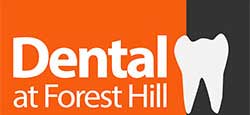Teeth Removal | Extraction
Tooth Extraction
Teeth Removal: At Dental at Forest Hill, we always try to fix a tooth has been broken or damaged by decay. In some cases, however, the dentist may opt to extract the tooth if the damage is too severe.

Types of Extractions
Whether you will need a tooth extraction depends on whether your tooth is visible or impacted. In general, there are two types of extractions:
Simple extraction: A dentist uses an elevator to loosen the tooth. A forceps is then used to remove the tooth.
A surgical extraction – During this procedure, the oral surgeon will make an incision in your gum in order to remove the broken tooth or impacted wisdom tooth surgically.
Medical Causes of Tooth Extraction
It is possible for your dentist to recommend extraction of your permanent teeth for the following reasons despite the fact that permanent teeth are meant to last a lifetime:

Chemotherapy, organ transplants, and bone marrow treatments that affect your immune system increase the risk of infection. Therefore, vulnerable teeth should be extracted by the dentist.
Dental Infection
If tooth decay extends to the gums and pulp, the dentist may recommend tooth extraction. A root canal procedure will be attempted first, and if the infection is too severe, the tooth will have to be removed. It is always the dentist’s goal to save a patient’s tooth.


There is no doubt that tooth decal is the most common reason for tooth extractions. Without regular dental visits, people are more likely to develop tooth decay beyond repair. During the early stages, there are no symptoms. Accidentally knocking the tooth off can also result in damage. Patients may suffer significant trauma that necessitates tooth removal.
Crowded Teeth
People sometimes have extra teeth that block other teeth, and children sometimes don’t lose their baby teeth in time, preventing permanent teeth from coming in. For people getting braces, there may be a need for space to accommodate their moving teeth. Often, this happens when dentists prepare the mouth for orthodontic treatment (aligning teeth properly).


A tooth infection can be fatal when delicate heart procedures like heart transplants, valve replacements, and congenital heart defects are performed. A dentist in consultation with a cardiologist will then remove any teeth at risk of severe infection in such cases.
Gum Disease
The tissues and bones surrounding the tooth can become loose due to severe gum disease. As a result, teeth become loose over time. Chewing food becomes hard and often kills the sensation on the teeth. Depending on the extent of the disease, the dentist may recommend extraction.

Immune System Disorders
It is important to let the dentist know if you have any pre-existing immune system problems, such as genetic immune disorders or immune problems caused by a previous illness. You must inform your dentist if you have had an organ transplant or organ failure. The reason is that tooth infection could exacerbate the organ problems already present in the body. Inform your dentist of any current illnesses or medications you may be taking.
The Process of Tooth Extraction
In most cases, tooth removal requires four steps and takes 30 to 90 minutes. In most cases, there is no pain experienced by the patient, only pressure during the extraction.
Application of Anaesthesia
In order to numb the tooth and the surrounding area, local anaesthesia is injected before extraction. Dentists may resort to general anesthesia when removing multiple teeth or when the damage is severe.
Teeth Removal
As soon as the tooth and surrounding areas become numb, the dentist will loosen it. Occasionally, a dentist may need to remove bone tissue and gum tissue to remove a tooth. A forceps will then be used by the dentist to remove the tooth.
Surgical Treatment after Extraction
A gauze pad is used to stop the bleeding, and a blood clot is used to fill the gap in the tooth. The dentist will apply self-dissolving stitches if the extraction involves cuts.
Post-Extraction Care
The socket will heal naturally once the blood clots. It is possible, however, for the blood clot to break and cause a condition known as dry socket. A sedative dressing is usually applied over the socket by the dentist. As soon as a new blood clot forms, the healing process resumes.
Healing and Recovery
A tooth extraction usually takes a few days to heal. During your recovery, keep these things in mind:
Immediately after extraction
- Bite on the gauze pad until a clot forms.
- To prevent swelling, apply ice cubes to the extracted area.
- Follow the dentist’s recommendations regarding medications.
For the Next 48 Hours
- In order to avoid dislodging the clot, do not use force while rinsing your mouth.
- Warm water mixed with salt should be used to rinse your mouth.
- Avoid sucking anything from a bottle or cup and avoid drinking from a straw.
Dietary Choices
- Smoking should be avoided
- You should eat soup, yoghurt, and other soft foods.
- Until the extraction area has fully healed, avoid brushing it.
Post-Extraction Risks
There are risks associated with tooth extraction, such as persistent bleeding, infection, swelling, and discharge. Get in touch with your dentist right away if such a situation arises.
Payment Options / Plans
Payment plans are essentially loans, which can support you in managing the high cost of dental treatment. Rather than paying for your dental work in an upfront lumpsum, a payment plan allows you to pay in instalments over a period of time. We have onboard, payment plan service providers who will make your payment plan’s instalments even more affordable.
There are several payment options available at our surgery including Cash, Cheque, EFTPOS, Credit Card, HICAPS, AMEX and Direct Deposit.






